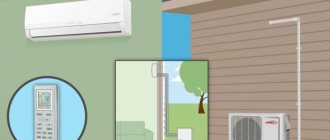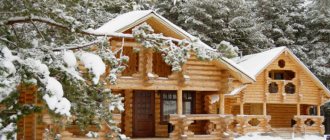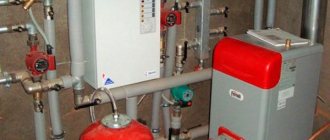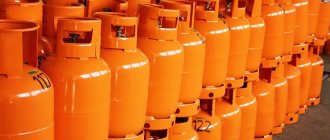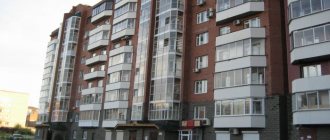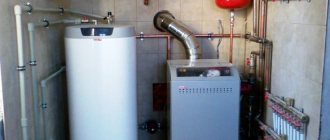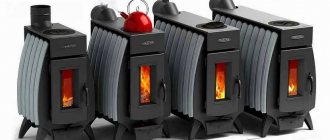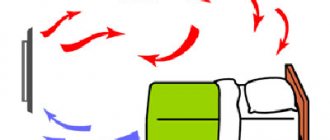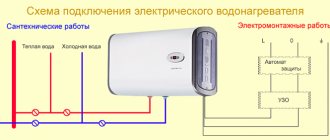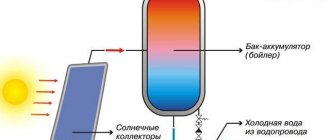Every modern inverter air conditioner can work not only for cooling, but also for heating.
It turns out that this device, in theory, can be used all year round, and not just during the summer heat.
True, there are people who still don’t believe in this, and you can easily find similar comments on the Internet.
By installing a good air conditioner as the main source of heating, you get rid of the problems with setting up and operating a gas or solid fuel boiler.
Radiators and heating pipes disappear from the rooms. There is no need to rack your brains about how best to lay out the system. Which pipes should be used to extend the supply and return lines from the boiler room in order to minimize losses.
How to adjust the temperature in the circuits. And many many others.
With an air conditioner, everything is simple and clear. Choose an installation location, pay 10-15 thousand for installation, or do it yourself, turn it on and use it.
However, do not forget that in fact, in this way you are switching to heating with electricity. All air conditioners are connected from an outlet.
And here a natural question arises: how profitable is such heating? Won't it be unprofitable compared to the same heaters or convectors?
To understand this, let's understand all the technical features and nuances.
Energy efficiency at home
Russian YouTube is full of videos about air-source heat pumps on air conditioners, and for some reason there is a clear tendency everywhere that if someone scolds them, they will definitely miss the advantages of the device and inflate the disadvantages, and vice versa.
This article will touch on both the positive and negative aspects of the issue.
Before you consider heating with air conditioning, check the insulation and energy efficiency of your home.
If it is useless, then no matter how powerful the unit you install, you will not stay warm in winter. And the type of heating has nothing to do with it.
It’s not for nothing that they say that the best heating is insulation! When everything is in order with this, you can start choosing an air conditioner.
Conclusions and useful video on the topic
How to use conditioner correctly:
A properly configured air conditioner will create comfortable temperature conditions in the room. At the same time, you won’t have to worry about someone catching a cold.
However, more complex manipulations with climate control equipment, for example, installation of a winter kit, should be entrusted to specialists. In this case, you will be sure that everything is done correctly, and your air conditioner will not fail ahead of time.
If you have questions or can supplement our material with interesting information on the topic of the article, please leave your comments and ask questions - the contact block is located under the article.
How does air conditioning work for cold and heat?
First, let's remember how a regular device works. Here is its basic technological diagram.
Any air conditioner is like a heat pump. That is, it pumps thermal energy between two heat exchangers.
The principle of operation during cooling is as follows. The entire system is filled with a special liquid - freon.
The built-in compressor in the external unit compresses it, which causes the freon to heat up. Then, passing through the condenser, it is blown by air currents and cooled, turning into a liquid state.
Since the compressor still continues to pressurize the system, the freon moves on and reaches the expansion valve or flow regulator.
Simply put, the diameter of the main tube in this place increases sharply, which means a drop in pressure occurs. Losing pressure, freon goes into a gaseous state and, according to the laws of physics, cools sharply.
In this cold state, it enters the second heat exchanger or evaporator. Moreover, its temperature here is significantly lower than the ambient temperature.
As a result, freon takes excess heat from it and continues its march, returning back to the compressor. The cycle ends and everything repeats for the second round.
The operating principle of an air conditioner is heating, which is the reverse of cooling. At the same time, in modern devices there is no need to install anything additional.
When operating for heating, the air conditioner reduces the refrigerant to a temperature lower than “outside.” For example, if freon is cooled to -30C after passing through the expansion valve, then it will quite easily take heat from the surrounding air, even if it is -15C or -25C.
The whole difference will go towards heat transfer.
The main advantage of this scheme is that much less energy is spent on the operation of the compressor than on generating the corresponding amount of heat that the air conditioner is able to pump between two heat exchangers.
However, all conventional air conditioners, when operating on heat, have a maximum operating temperature. As a rule, it does not exceed -5C.
If you operate it at -10C and below, the air conditioner will go into the so-called zero efficiency mode.
The compressor will stop turning off altogether, will work at its maximum capacity and will eventually burn out.
To make it possible to warm up at lower temperatures, inverter models were invented.
Ventilation of the room with air conditioning
There is one more important thing to consider. The air conditioner does not interact with the air outside in any way. It circulates the same air around the room, and the external installation is only responsible for removing excess heat from the room.
Only refrigerant moves between the indoor and outdoor units of the air conditioner, usually freon. It removes excess heat from the room, but does not renew the air
Air exchange is also important to maintain comfortable indoor conditions. And if you do not ventilate the room for a long time, the oxygen level will decrease and the level of carbon dioxide will increase. Of course, this is not fatal, but the lack of oxygen can make you feel tired and drowsy.
Before ventilating the room, be sure to turn off the air conditioner. Open windows and, if possible, doors. This creates a draft, but allows the air to renew itself very quickly. It is advisable that at this moment there is no one in the room, especially children. If there is no way to vacate the room, then it is better to limit yourself to windows only.
We said above that when the air conditioner is on, it is necessary to close the windows, and when ventilating, turn off the air conditioner. Let's figure out why this needs to be done.
Modern air conditioners do not blow at the set power all the time. They cool the room to a set temperature, after which they begin to work to maintain it. This allows you to wear out the equipment and filters less quickly and save energy.
If you open the windows when the air conditioner is on, active air exchange will begin to occur in the room. Hot air from the street will replace the cooled air in the room. In this case, the air conditioner will work at full capacity, actually cooling the street.
Powerful models may be able to maintain the set temperature even with the windows open, but this will lead to rapid wear and tear.
If you forget about it once, then nothing bad will happen. However, repeating this on a regular basis, there is a high chance of being left without air conditioning and with a huge electricity bill.
We also recommend reading our other article, where we described in detail the principle of operation of the air conditioner.
The difference between the operation of an inverter air conditioner
What is an inverter air conditioner and how does it differ from a simple one? The traditional device works according to a simple scheme: it heats the air to a certain temperature and immediately turns off the compressor. The so-called ON-OFF system.
That is, the compressor either works or doesn’t work at certain periods of time. But in inverter models it is possible not to completely turn off the compressor, but to reduce its rated power.
Why does this happen? Due to double conversion of electric current.
Initially, the standard alternating voltage from a 220V outlet is converted to direct voltage. And only then, with the help of an inverter, the direct current is again converted into alternating current, but not with the usual frequency of 50 Hz, but with an arbitrary one.
By adjusting and changing this very frequency, you can regulate the speed of the compressor rotor, and therefore change the power during operation.
You may ask, why all these troubles with frequency and power, and what exactly do they give? And they provide several advantages:
- absence of large starting currents when turned on
- less equipment wear
- but most importantly, a lower permissible operating temperature
That is, inverter models are able to start and operate at outside temperatures of -15C and below (-25C and even -30C). The oil in the system does not stagnate, but circulates constantly.
Most inexpensive household inverters certainly do not reach such low temperatures and operate normally between -5C and -7C.
If you installed such a household model at home, and the frost outside hit -25C, is it possible to turn it on or not? There are several options here.
Firstly, it may simply not start and go into defense. But if it does start working, its efficiency will drop significantly, as will the temperature in your house.
If such a low temperature remains for several days in a row, the oil in the device will thicken.
In this case, it is not recommended to turn off the air conditioner, otherwise a subsequent cold start will kill its compressor.
During operation, for better heating of the room, all inverter models must be able to direct the air flow vertically downwards. In this case, the room will warm up much faster. There is no particular point in heating the ceiling with warm air.
Because of this feature, some advise placing the indoor unit as low as possible, at a level of 0.5 m from the floor. True, in summer such cold for the feet will be very unpleasant.
So look for a compromise.
Why is it important to observe the temperature difference?
Modern climate control equipment works wonders. Outside the window it may be incredibly hot at 40 degrees, but indoors the air conditioner can maintain a comfortable coolness of 20 degrees.
But it is worth considering that sudden temperature changes of more than 7 degrees can cause ARVI with further exacerbations, even pneumonia. If you walk from a hot street into a cool room with air conditioning, you will feel comfortable. However, the risk of getting sick will increase several times.
If you stay indoors all day, maintaining the temperature difference can be neglected. But being under a cold stream all the time is not recommended.
Therefore, it is necessary to set the temperature of the air conditioner in rooms where people often enter and exit, taking into account the above difference.
If we are talking about office space, then failure to comply with this simple rule can lead to all employees going on sick leave.
COP and air conditioner efficiency
However, the ability to operate at low negative temperatures is not the main thing. What else should you focus on when choosing an inverter air conditioner, so that its operation creates a sufficient amount of heat in the house and is profitable at the same time?
The COP (Coefficient of Performance) coefficient is responsible for this - the coefficient of efficiency or conversion. It can be found in the full list of characteristics.
COP is the ratio of the thermal performance of an air conditioner in heating mode to its electrical power, that is, how much electricity it consumes from the outlet.
What COP value is considered good? For the best models it reaches 5 units. From 3.5 to 4.0 these are average parameters.
For example, cop=3.61 means that with a power of 1 kW, such an inverter is capable of pumping a thermal power of 3.61 kW into the room in 1 hour.
A similar parameter when working for cooling is called coefficient. EER. It shows how much thermal power is pumped out of the room in accordance with the consumed electrical power of the air conditioner.
The higher the COP, the more profitable and expensive the air conditioner. As mentioned above, a good value is COP=5.0. Having such a device, having spent one kilowatt of electric energy in 1 hour, you will drive 5 kW of heat into your room.
How profitable is this? At current prices for electricity, 1 kW of heat when heating with such an air conditioner in Moscow or the region will cost you about 1 ruble.
In some regions, costs will be one and a half times less. It seems that it is even cheaper than heating with wood, not to mention heating with other electrical appliances.
But this is where the main trick lies. The OPC parameter specified in the technical documentation was measured under some ideal conditions. Specifically, when working for heating with an ambient temperature of +7C.
As the outside temperature decreases, the COP will decrease, just as it does when the room temperature increases. If the best Japanese inverters have a COP of 5.0 at outdoor temperature t=+7C and room temperature +20C, and you want to heat up the room to +30C without changing the outdoor parameters, COP will immediately drop to 4.0-4.5.
And if it gets colder outside, this parameter will drop much more. In frosts of -25C, branded “Japs” have a COP within the range of 1.5-2.0. That is, the efficiency drops by half.
So what, you say. It’s still more profitable and 2 times cheaper than heating with oil batteries or a convector. Actually not quite like that.
How to act independently?
How to prepare an air conditioner for winter without resorting to the help of specialists? In fact, this is not difficult to do; it just takes a few steps.
- First, you will need to turn on the device for a couple of hours in the cooling fan mode, and then let it run for about that long in the heating mode. This will allow all internal parts of the equipment to dry completely.
- Remove dust from the outside using a damp cloth. Microfiber is best.
- The filters should be washed to remove all accumulated dust and dirt.
- The system must be completely de-energized and the batteries removed from the remote control to avoid accidental activation.
No additional actions are required, and doing all of the above is very simple, and it will not take much time, but it will extend the life of the air conditioner.
If the split system you are using is located on the windy side, then you can think about additional insulation for the unit. The outer one is wrapped in cellophane, and the inner one is also covered and the drainage hole is plugged. This will help protect against cold air entering directly into the apartment through the air conditioning system.
When is air conditioning beneficial?
As mentioned above, manufacturers indicate “cop” under ideal conditions. They are “modestly” silent about the energy consumption for defrosting or defrosting cycles, the number and duration of which increases at -15C and below.
Add here the extra kilowatts for heating the sump and compressor crankcase. What's left in the end?
And as a result, at temperatures from -15C, even with a relatively modern inverter, you will save energy in the region of 10-20% compared to conventional heaters.
If the COP was initially low (domestic model), then you will not receive any benefit at all. It's the same as buying a 2-kilowatt heat blower and running it under the ceiling.
Therefore, look at the average annual winter temperature in your region and in the presence of prolonged cold weather, buy air conditioners with a COP efficiency rating of 4 or higher.
Only in this case will heating with air conditioners be more profitable than heating the room with direct heating devices.
To understand the effectiveness of a particular model, you need to compare their COP graphs depending on the ambient temperature.
Choosing a split system with heating function
The range of climate systems includes a large selection of air conditioners with heating functions. When purchasing such a device, it is recommended to pay attention to important criteria.
Selection options:
- Energy efficiency category.
- Range of permissible operating temperatures.
- Thermal energy productivity.
- Energy consumption power.
- The area of the room and its purpose (living room, industrial premises, etc.).
- Availability of condensate auto-defrost mode.
Inverter models of air conditioners complete with winter equipment, which operate effectively in a wide range of sub-zero temperatures, have received good reviews.
Cassette air conditioner: features and advantages
Comparison of air conditioners when operating for heating
Below are independent results of research and measurements of this coefficient (taking into account defrosting cycles!), which were carried out with some of the highest quality brands of air source heat pumps - Mitsubishi Electric, Panasonic, Gree, Fujitsu. To view, click on the appropriate tab.
Mitsubishi ElectricPanasonic CS-NE9MKEPanasonic CS-HE9LKEGreeMitsubishi HeavyFujitsu
Mitsubishi Electric MSZ-FH25VE + Mitsubishi Electric MUZ-FH25VEHZ
Panasonic CS-NE9MKE + CU-NE9MKE
Panasonic CS-HE9LKE + CU-HE9LKE
Gree Hansol 25-A (GWH09TB-S3DNA2D/I) + GWHT09TB-S3DNA1D/O
Mitsubishi Heavy Industries SRK25ZJX + SRK25ZJX-SA
Fujitsu ASYG09LMCB + AOYG09LMCBN
The market leader is Mitsubishi Zubadan. However, you should not believe the marketing and purchase budget models of this brand. They are distinguished from conventional splits mainly by a more powerful compressor. You are unlikely to get normal heating at -25C from them either.
The energy efficiency of real Zubadans, depending on the region of your residence and the average temperature in winter, can be calculated on a convenient online calculator on the Mitsubishi website here.
Based on the above tables, you can make your choice. Complete data on the most popular and effective brands with test reports are available via the link here (site in Finnish, use Google translator).
If COP is not initially indicated anywhere on the device, you can calculate it yourself. To do this, divide the thermal power, which is written on the device nameplate, by the consumed electrical power.
How to choose the power of the air conditioner according to the area of the room, read a separate article.
Set a reminder to remove the cover
Your AC unit will not work very well with the cover in place and may even be damaged by it, so you should be sure to remove it before AC season comes around again.
It doesn't matter what date you use as a reminder, as long as that date is on your calendar and falls before the time of year when you turn on the air conditioner.
For most people, adding it to your Daylight Saving Time task list is an easy way to remember or add it to your spring task list, like pulling out the garden hoses and the like.
Covering your AC unit may seem like a hassle, but with the price of everything going up, a few minutes spent tinkering with the cover twice a year could save you a lot of money over the years.
Switching the air conditioner to heat
How to properly switch the air conditioner to heat? First, make sure that it is actually designed to operate in sub-zero temperatures. Check the documentation for the maximum degrees.
Switching from cooling mode to heating mode is carried out using the remote control.
In the menu or on the buttons, select the Heat mode, or the key with the sun icon.
Please note that in some remote controls, until you remove the batteries and insert them back, the “sun” icon will not appear on your screen. This is the so-called child protection so that they do not accidentally switch the air conditioner to heat in the summer.
Remember, warm air does not start flowing immediately, but after 5-10 minutes.
How to set the temperature correctly in summer?
Comfort is a very relative concept. Some people may feel fine even at 30 degrees, but for others it may seem like real hell. There are no standards for the operating temperature of an air conditioner in the legislation, but there are requirements of SanPiN 2.1.2.2645-10 that regulate the temperature in residential buildings during the warm season.
It is from this document that you should start first of all, SanPiN 2.1.2.2645-10 states that the optimal temperature in the room will be 22-25 degrees. It is also worth paying attention to the instructions for the air conditioner; it will indicate what temperature is optimal to set.
If it is 30 degrees outside, then the optimal temperature of the air conditioner will be approximately 25. SanPiN 2.1.2.2645-10 allows deviations of up to 20-28 degrees. But at this temperature the absolute majority will be uncomfortable and it is better not to expose it to air conditioning.
Some air conditioner models can automatically adjust the room temperature based on how many degrees it is outside.
It is recommended to set the desired temperature in several stages.
For a heat of 30 degrees it will look like this:
- turn on the air conditioner and let it cool the room to 28 degrees;
- after 10-15 minutes you can reduce the temperature to 25 degrees;
- after 30-40 minutes the temperature can be lowered to 23 degrees.
It is not recommended to cool the air below 23 degrees, as in this case a person’s blood vessels begin to narrow.
This is a natural protection against hypothermia, but it causes discomfort in the form of drying out the mucous membranes of the nose, throat and eyes.
Features of operation in winter
In winter, the air conditioner defrosts at certain intervals. This usually happens once every 40-60 minutes.
When working for a long time at subzero temperatures, its radiator freezes over, efficiency drops, and the system begins to deal with it on its own.
Many people mistakenly believe that the external unit in this case is heated by some kind of built-in heating elements. This is wrong.
It simply switches the direction of its work. That is, hot freon from the indoor unit begins to flow into the outdoor unit. And it thaws within a few minutes.
The duration and frequency of defrost cycles depends on the degree of icing and is controlled by sensors. Although in inexpensive options this happens simply according to the programmed time.
Comfortable stay in an air-conditioned room
Temperature is the most important factor, but not the only one, that is affected by the air conditioner turned on in the room.
In addition to maintaining the temperature at a set value, the air conditioner dehumidifies the air. This can cause the mucous membranes of the nose and throat to dry out. For some people, this causes discomfort in the form of a runny nose and sore throat.
The optimal air humidity is considered to be 40-60%. It is measured using a hygrometer. Modern devices, in addition to humidity, report other important components of the microclimate
You can avoid this by installing a humidifier in the room. It is also recommended to drink more water, this will protect your mucous membranes from drying out.
Defrosting the air conditioner and heating the pan
The water that thaws from the radiator grilles flows into the pan and ice begins to accumulate there. If it is not removed, it bends and deforms the heat exchanger tubes. Here are the clear consequences of such freezing.
Sometimes he even gets to the fan. To prevent this from happening, choose models with a heating cable built into the tray.
If you don’t have one, you’ll have to remove the lid of the device each time and use a hot kettle to pour over the frozen areas. You can’t knock anything down manually, otherwise in the cold you’ll only make it worse.
A heating cable built into the tray is an extra expense of electricity, which manufacturers are silent about. It turns on based on the temperature sensor and will generate kilowatts, even if the air conditioner is not working, but is simply plugged into the outlet.
About 2 kW can run per day.
In the tray of non-sophisticated models, you can build your own cable, bringing out the wires for connection in a separate circuit. Attach a plug to the end of the cable and turn it on through the timer socket.
In order to determine the optimal operating time, observe the air conditioner for several days and record the moments when ice forms.
Please note that if you have a new condo, you cannot drill any holes for cable fastening or additional water drainage, otherwise you will lose your warranty. Craftsmen use neodymium magnets to secure the cable.
A similar cable is used for roof heating or for heated floors outdoors.
In addition to the pallet, a couple or three turns of such wire are made around the compressor. In cold weather, this prevents the oil from thickening and makes it easier to start the device.
However, if your split system is not initially designed to operate in winter, such a home-made winter kit will not help, and even harm!
In these devices, the compressor has a slightly different winding configuration. In addition, the valves in them are designed for different condensation/boiling pressure modes.
You will also need an electronic expansion valve to keep the freon overheating on the evaporator to a minimum, and therefore work as efficiently as possible under any thermal conditions from -30C to +15C. Without all this, you will ruin your device.
One thing should not be confused with all this heating - factory winter kits for air conditioners are designed to work in winter for cooling!
When working with heat, you only need to warm up two things:
- compressor crankcase
- pallet
During the defrosting process, ice will accumulate under the air conditioner.
It would be good if it was in the form of a stalactite. He knocked it down with a crowbar and threw it aside. But most often it spreads over a large area, causing heaving of the soil and even movement of the foundation.
How to deal with this? Place a deep rubber tray under the air conditioner. All you have to do is periodically pull it out and shake it free of ice.
What temperature should I set for sleeping?
Properly setting the air conditioner temperature can provide you with a comfortable sleep. Many modern models have a “sleep mode”; just turn it on and you can go to bed. The required temperature will be set automatically.
If it is not there, then the settings must be set manually:
- Raise the temperature 1-2 degrees above daytime. At night, the human body cools down and additional heating is required.
- Adjust the blinds so that air flows do not flow onto the bed.
- Set the shaft rotation speed to minimum. In addition to maintaining the temperature regime, this will make the air conditioner quieter, which also contributes to a comfortable sleep.
Based on general recommendations, it turns out that the optimal temperature for sleeping will be 25-27 degrees.
“Sleep mode” works according to the following principle. First, it resets the fan speed to minimum. Secondly, it directs the blinds so that the air flows parallel to the floor. Thirdly, it increases the temperature to the desired level.
Some models increase the temperature in several stages. First, the temperature rises to 25-26 degrees, and by the middle of the night to 27. This allows you to sleep in comfortable conditions and not freeze
The only problem that may arise during sleep is ventilation. Having set the optimal air conditioner temperature for the night, do not forget that the windows must be closed, otherwise the equipment will wear out.
If the flow of clean air is very important, then you can leave a small gap in the window, but this is the permissible maximum.
Modern double-glazed windows have a micro-ventilation mode. It will be a good compromise between fresh air and comfortable temperature at night
Another option to solve this problem is to ventilate the room immediately before going to bed. During sleep, a person consumes significantly less oxygen and this should be enough for the whole night.
Winter maintenance
How should an inverter air conditioner operating for heating be maintained? Apart from ice removal, maintenance is no different from any other air conditioner.
If you do not want to breed mold and mildew, it is enough to clean its filter once every two weeks and wash the impeller twice a year after disassembling the device. All bacteria and fungi that are dangerous to health also accumulate there.
Other types of work, for example, topping up freon or inspecting the external unit, should be carried out by specialists with the appropriate equipment. You better not go there.
Wrong way to cover an AC unit
Do not do that.
Your air conditioner doesn't like being suffocated. IkeHayden / Shutterstock.com If your situation requires covering your AC unit, then it seems pretty simple, right? Just go to your local hardware store and get a large plastic bag box, or even wrap it in a small tarp and some bungee cords. This is probably what your neighbors are doing, so it looks like you should too.
Just not so fast. Covering your air conditioner this way is ultimately worse for your poor AC unit than not covering it at all. Why? When you wrap your air conditioner in a Christmas present style that covers not just the top of the unit but the sides all the way down to the ground, you create a chamber that traps moisture and speeds up rust formation.
Of course, top-to-bottom lids that close completely will keep out rain and snow that falls directly on the unit, but as anyone who has stored anything outside with a tarp knows, eventually moisture from the environment will rise up and get trapped under the tarp. Even lids with small holes for ventilation and the like on the side do not allow moisture to pass through easily.
While properly sized commercial covers are imperfect at best, doing what you see in the photo above - wrapping the entire unit in an oversized plastic tarp - is the worst method. No breathability, no vents, just moisture rising from the surrounding soil and getting trapped under the tarp.
What is a winter kit and what is it for?
A winter kit is a set of special devices that ensure safe operation of the air conditioner at temperatures below the range specified by the manufacturer. It includes crankcase heating, drain heating, and fan speed control. With the help of these devices, icing of the drainage system, the formation of ice on the body, thickening of the oil and overcooling of freon are prevented.
In the photo: Winter kit for Dantex air conditioner
But when using a winter kit, it is very important not to forget that air conditioners equipped with it can only work for cooling. Heating in this case is possible only within the temperature limits indicated in the technical characteristics of the device.
Care
No special care of the air conditioner is required in winter if you do not plan to use it throughout the frosty period. It is enough to carry out preparatory work on cleaning and de-energizing, and in the spring call a specialist to carry out comprehensive maintenance.
If you use an air conditioner in winter, you need to take care of it from time to time - clean the external panels and mechanical filters of the indoor unit, and also, if necessary, wash the fan and heat exchanger radiator in the room module.
The frequency of treatment depends on the dustiness of the room and the number of people constantly present there. If you have carpets, rugs, curtains and other fabric surfaces, cleaning will have to be done at least once a month. If the room is slightly dusty, it is not necessary to maintain the air conditioner so often in winter. Cleaning once a season is sufficient.
The most basic point of high-quality air conditioner care is still compliance with the established framework, even for systems with an extended operating temperature range. It is also worth remembering that when turning on the device in cold or warm conditions, you should not keep the window and balcony door open.
Flaws
If the above conditions are not met, it is not necessary to install a hood for the outdoor unit of the air conditioner. In addition to its protective function, it can cause significant inconvenience:
- accumulation of dirt may impair its performance. Rain does not fall under the canopy, dirt accumulates. In addition, birds love to settle there. The result of such a neighborhood can be seen in the video:
- installation of the system on floors above the fifth is carried out with the participation of industrial climbers, which significantly increases the total cost of installation;
- In case of unsuccessful installation of the protective canopy on the upper floors, air access to the device may be blocked, further servicing. You will have to call industrial climbers and special equipment;
- the presence of a canopy makes it much more difficult to replace the device if the need arises.
Design of air conditioning systems. How important is it? >>>
